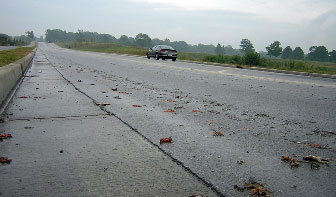Roads are a major killer of amphibians, reveals study
Roads are a major killer of amphibians, reveals study
Rachel Tompa, special to mongabay.com
May 29, 2008
Frogs, toads, and salamanders worldwide are dying from mysterious causes, with possible culprits ranging from habitat loss to fungal diseases. Now, researchers at Purdue University believe they may have identified a significant and surprising contributor to global amphibian declines: traffic. In a recent study, the scientists looked at road kill along several stretches of road in northwestern Indiana and found that 93 percent of the dead animals were amphibians.
The scientists surveyed 7.5 miles of Indiana roads at four different sites near Purdue twice a week for 17 months. They counted more than 10,500 dead animals, of which more than 9,800 were amphibians. Most of these hopping, crawling or wriggling critters were found along a one-mile stretch of a road bisecting Celery Bog Nature Preserve, a wetland in West Lafayette.
The large numbers surprised the researchers. “We didn’t have any appreciation of the magnitude that’s involved,” said Purdue biologist Andrew DeWoody, senior author on the study. The report was published in the February 2008 issue of Herpetological Conservation and Biology.
 Amphibian and other road kill along Lindberg Road in West Lafayette, Indiana. Photo courtesy of Andrew DeWoody. |
David Glista, the report’s first author and now an environmental scientist with the Indiana Department of Transportation, said he was expecting to find a few hundred animals killed by cars over the course of 17 months, and that most would be deer, raccoons, and opossums. “I went out on the first day to the Lindberg Road site [at Celery Bog] and counted over 200 dead frogs in one visit,” Glista said. “It was a big eye opener.”
To count the road kill, Glista and two research technicians drove slowly along their survey sites and stopped the vehicle whenever they saw a dead animal on or next to the road. Glista marked each one with biodegradable paint so that he wouldn’t count it again later, recorded its coordinates with a GPS system, and identified the animal visually. Most of the dead frogs he found were too desiccated or decomposed to identify their species, he said. DeWoody is now expanding these surveys to include eight more sites. His team will start genetic analysis to pin down the species of some of the unidentifiable frogs.
Amphibians may be prone to becoming road kill because they migrate along certain paths, DeWoody said. During breeding season, adult frogs, toads and salamanders migrate to breeding ponds to mate. A few months later, when the juveniles have matured, they migrate away from those ponds. If the breeding ponds are near a road, as was the case at the Lindberg Road site, that’s a lot of potential trouble with traffic.
Glista said that he found more dead frogs after humid or rainy nights. He speculated that on cool nights the frogs might be drawn to the blacktop, which retains heat from the day, or that tasty prey — such as insects, spiders and worms — might come out on the road after a rain. He added that Lindberg Road has high curbs with few breaks in the curb. Once frogs got onto the road, it might have been hard for them to climb over the barrier and get back off.
While Glista and DeWoody agree that loss of habitat is likely the leading cause for global amphibian declines, they think the numbers of amphibian road kill they’ve counted are high enough that they could be a major factor. Even among the few sites they sampled, there was huge variability in the numbers of dead frogs on each road, so the biologists can’t extrapolate their numbers to global levels. But it’s likely that similar deaths happen on roads near or in wetland areas in other parts of the world, they believe.
“If it’s happening at these levels in Indiana, and it’s happening at similar levels in other places, you can do the rough math and say that’s a lot of dead amphibians we may not be accounting for,” said Glista.
 A dead tiger salamander on State Route 26 in Tippecanoe County, Indiana. Photo courtesy of David Glista and Andrew DeWoody. |
Evidence does suggest Indiana is not unique. “Roads take a tremendous toll on amphibian and reptile populations,” wrote Ken Dodd, a biologist at the University of Florida, in an email to Mongabay. Dodd has done road kill surveys on roads near wetlands in Florida and found large numbers of dead snakes and frogs.
“What we need are ways to mitigate this mortality, especially at road crossing ‘hot spots,'” Dodd said. “The type of work that [Glista] conducted will help us identify these hot spots.”
This problem is solved most easily through road-construction practices, Glista said. Transportation agencies should avoid building roads through wetlands, he said, but if they must be built, they should allow amphibians to cross more safely. Roads can be slightly elevated so that frogs and toads can scurry under them, Glista said, or can incorporate special “toad tunnels” to provide safe passage to the other side. Many roads in Europe use such tunnels, he noted, and he hopes more American cities will follow suit.
Rachel Tompa is a graduate student in the Science Communication Program at the University of California, Santa Cruz.







